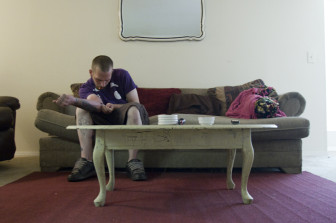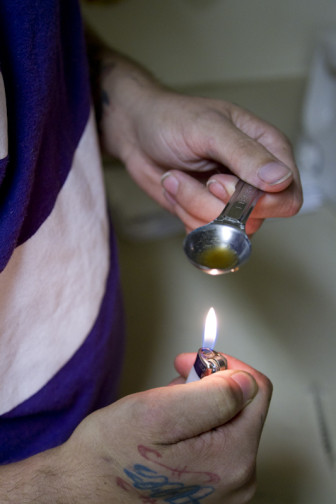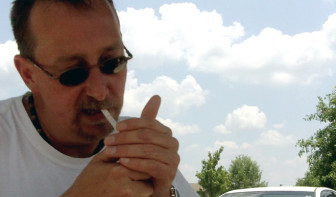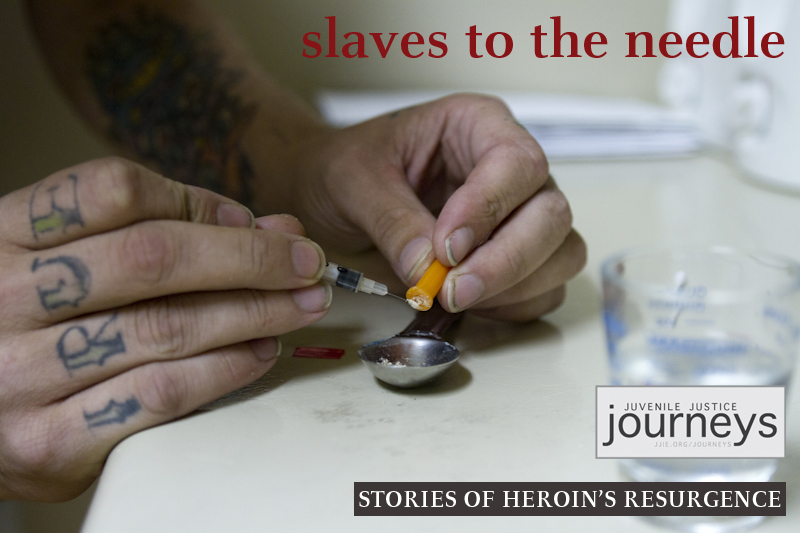
Photo by Clay Duda
In the South, heroin is marketed differently. An Atlanta drug market analysis from 2010 prepared by the National Drug Intelligence Center says white, suburban youth are increasingly driving into the city, buying a few days worth of heroin and then heading back home where they sell some and use the rest.
Chris Davis, now 24, was one of those suburban youth. He first got hooked on opiate-based pain pills when he was in high school in suburban Atlanta.
“It progressed to snorting pain pills and it wasn’t enough so I moved on to heroin,” Davis said. “[Heroin] ruined everything.”
Chris Blum took a similar path to heroin addiction. He first began smoking marijuana and drinking when he was 16. But his addictions escalated.
Never say never, said Blum, now in his early 40s. “You think, ‘Oh I’m just drinking and smoking a doobie.’ But that’s how it starts.” Soon, he was snorting heroin with friends. It wasn’t long before he was shooting up intravenously.

"Cooking" heroin. Photo by Clay Duda
The simplest way to understand heroin addiction is to understand the brain. In one of the oldest parts of the brain — the midbrain — sits the reward center, the factory where dopamine, a hormone involved in motivation and reward, is produced and released into your body. The midbrain releases dopamine during sex or while eating an enjoyable meal, for example, and quite simply, it’s what makes you feel good. Heroin recreates that feeling by binding to receptors in your body that would normally bind with dopamine.
“It was like total relaxation — euphoria,” Chris Blum said of his first heroin high. “My eyes lit up. Everything got bigger and broader and pretty. I felt cool, you know?”
The high is so strong because heroin is able to break through the blood-brain barrier and mimic the effects of dopamine. But, noticing what appears to be extra dopamine, the brain cuts back on its own dopamine production. It stops making the hormone for itself and suddenly the body needs heroin to restore balance. To replace the missing dopamine, heroin addicts must continue to inject over and over. They become physically dependent even as the high becomes weaker and weaker.
The first high is the best, Blum said. “Then you chase that high. The more I did, the more I did.”
Blum said his addiction was “pretty much instant” and escalated from his first use to, “Man, I got to do that shit again.”
“Heroin — it calls your name, brother,” he told me. “You wake up and that is your first thought: If I don’t have any, how am I getting some?”
The life of a heroin addict can very quickly spiral out of control and dissolve into a cycle of getting high, followed by finding more drugs, followed by getting high. Without a consistent influx of heroin into the body, addicts begin experiencing intense, painful withdrawal symptoms, the National Institute on Drug Abuse said.
That’s where Chris Davis is now, constantly fighting off withdrawal.
“Within eight to ten hours of [using heroin] I start throwing up, having diarrhea, getting hot and cold chills, hurting all over,” Davis said. “I get real anxious and I just feel like there is another person inside of me that just wants to claw its way out and kill somebody.”
For Blum, heroin became the only thing he cared about. But the lethargy that followed the high robbed him of his ability to function normally. Everyday chores such as going to the grocery store became impossible.
“A normal person starts at zero and when they get high they get to 10,” Blum said. “An addict starts at negative 10 and needs to get high just to get to zero, to function.”

Chris Blum. Photo by Ryan Schill
Blum’s life was consumed with finding more drugs — or the money to buy more drugs. As Blum put it, “Next thing you know you’re in the back alley sucking some guy’s cock to get a fucking fix. I’ve seen it. I’ve seen guys go down that road.”
He lost everything: his well-paying job managing a large business, his family and eventually his home. He overdosed once — an experience that nearly killed him — and after a few years, he found himself alone in a dirty motel room wanting to die but unable to follow through with suicide.
“If [heroin] doesn’t put you in treatment or in jail, it’ll kill you,” Blum said. “That’s the only outcome … The last year: man, I prayed to die.”
Alone in his motel room, Blum hit rock bottom.
“All I knew was, I couldn’t stop,” he said. “I was hurting people. The nightmares didn’t stop. I was useless to my family.”
Shaking his head he told me that was the moment was when he knew he’d had enough.
“Fuck it, I’ll meet my maker,” he said he thought at the time.
But after a weekend of trying to overdose, Blum woke up before sunrise on Monday morning disgusted with himself.
“Now what?” he asked himself. “I can’t even fucking kill myself right.”

a sad but true story , having worked around addicts
you can look into their eyes and see their hooked